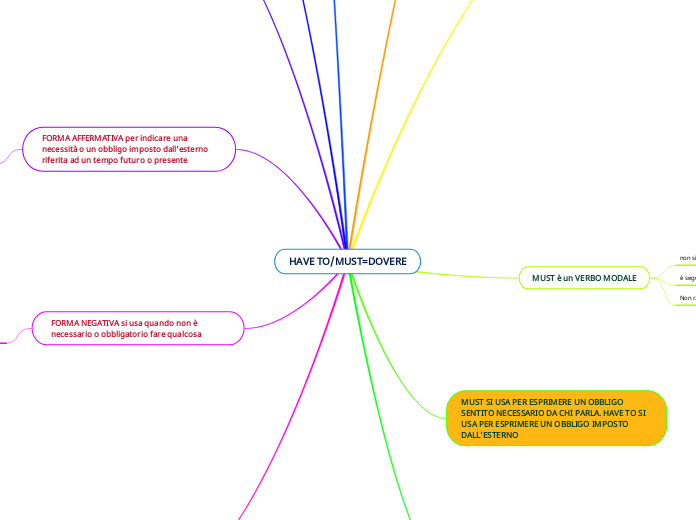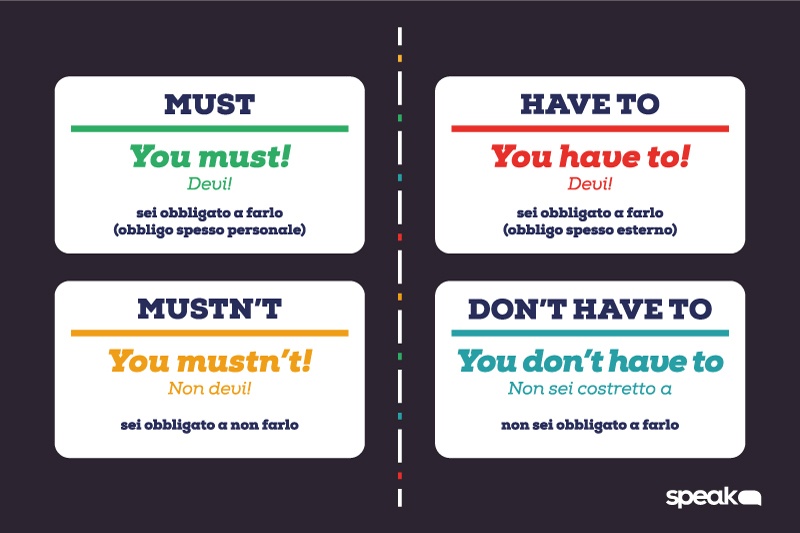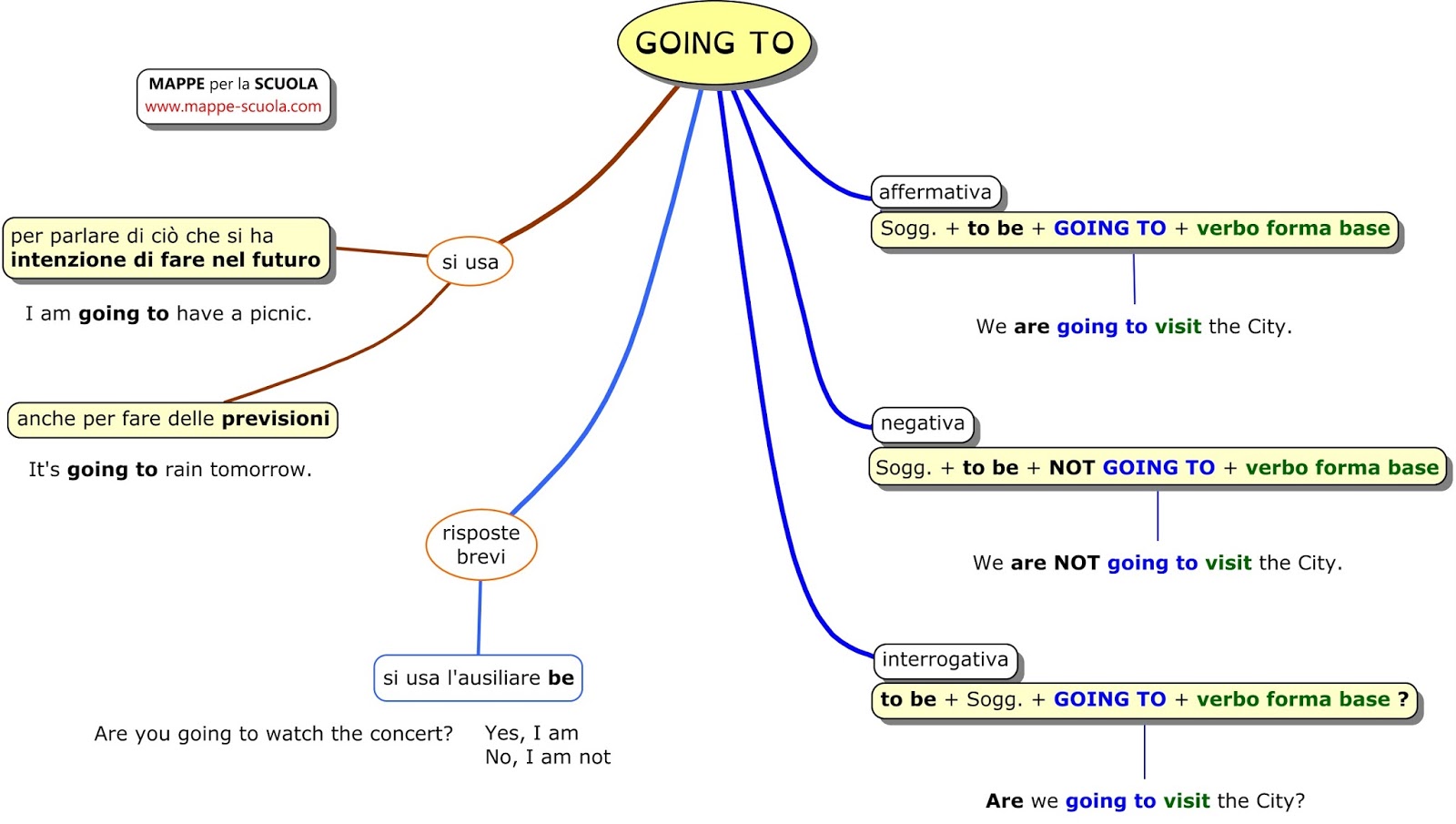
MAPPE CONCETTUALI PRONTE VUOTE DA SCARICA
Use of have to. In general, have to expresses impersonal obligation. The subject of have to is obliged or forced to act by a separate, external power (for example, the Law or school rules).Have to is objective.Look at these examples: In France, you have to drive on the right.; In England, most schoolchildren have to wear a uniform.; John has to wear a tie at work.

mappa concettuale HAVE TO e MUST Mind Map
HAVE TO - mappa sintetica, Schemi e mappe concettuali di Inglese Scarica Numero di pagine Mappa sintetica sull'utilizzo di have to, con alcuni esempi e esercizi Vedi l'anteprima Caricato il 01/15/2022 gaia-giraudo🇮🇹 Prepara al meglio i tuoi esami

MAPPE per la SCUOLA TO HAVE GOT
(1) Il verbo dovere in inglese: must e have to (2) Have to, don't have to "Must" e "have to": il verbo "dovere" in inglese. Teoria + esercizi differenza must e have to (1) Must have to differenza tra i due (1) simulazione II esame di recupero di prima superiore, esercizi di rinforzo (da stampare) (3) Have to/ must/ should

Educational infographic Must vs Have to Your
must / have to - Mind Map DOVERE (sentito come proprio) DOVERE MUST + VERBO ALL'INFINITO MUST You must tidy your room. She must study history for tomorrow. MUSTN'T You mustn't eat in the IT lab. Mark mustn't be so stubborn. HAVE TO + VERBO ALL'INFINITO HAVE/HAS TO We have to be at school at 8.30 am

Mappa concettuale Vygotskij Docsity
8383 Must e have to Il passato è had to. I couldn't come to the party because I had to study. = Non ho potuto venire alla festa perché dovevo studiare. forma negativa è don't / doesn't have to + forma base del verbo e indica che non è necessario fare qualcosa. Ha quindi un valore diverso da mustn't (= divieto). We're going out for dinner.

LANGUAGE FOCUS Le differenze tra Must e Have to
Scarica Schemi e mappe concettuali - Have to, must e should | Università degli Studi di Roma La Sapienza (UNIROMA1) | Mappa per Have to, must and should. Have to, must e should | Schemi e mappe concettuali di Lingua Inglese | Docsity Prepara i tuoi esami Ottieni punti Guide e Consigli Vendi Documenti Prepara i tuoi esami

Easy English Grammar, English Grammar Worksheets, Grammar Lessons, Mind
you 108108 M 1 Sostantivi, articoli, pronomi, aggettivi ronomi Personali soggetto i you he she it we they me him her us you them comPlemento il Plurale dei sostantivi -s, -ss, -ch, -sh, -o, -x, -z: bus buses class classes tomato tomatoes wat ch wat es dish dishes box boxes -o (di origine straniera): piano pianos con una consonante + -y: baby babies country countries -f, -fe:.

Paradiso delle mappe Must mustn't
MUST and HAVE TO are both used to express an obligation, responsibility or necessity. While Must can generally be replaced by Have to in the present tense, there is sometimes a slight difference in meaning or use. Let's look at our previous example using MUST: I must write a letter to John.

Pin su σχολειο
In qualche situazione però è più facile sentire la differenza tra MUST e HAVE TO. Se è un obbligo molto forte, a cui non ci si può sottrarre, è meglio usare MUST. Esempio: If you want to go to the USA, you must have a passport. Your leg is broken. You must go to the hospital. MUST è un vecchio verbo, usato tanto tempo fa, perciò si.

MAPPE per la SCUOLA GOING TO
MUST-MUSTN'T, DON'T HAVE TO e DO I HAVE TO Mappa concettuale su MUST-MUSTN'T; DON'T HAVE TO e DO I HAVE TO? Il verbo must si usa per esprimere un obbligo ( must: dovere; must not: divieto ). Don't have to si usa per dire che non necessita fare qualcosa. Do I have to si usa per formulare domande riguardo un obbligo.

Have tomust Tecnicas de enseñanza, Clase de inglés, Gramática inglesa
Must e have to hanno un significato molto simile. Entrambi indicano un obbligo, ma c'è una leggera differenza nel loro uso. - Must si usa per esprimere un obbligo sentito come necessario da.

What's the Difference Must vs. Have to, Must Not vs. Don't Have to
Nelle frasi affermative si possono usare must e have to con poca differenza di significato, poiché molte azioni sono importanti sia perché noi pensiamo così, sia perché ci sono delle regole. Nelle frasi negative si usa spesso mustn't per dire che una determinata azione è contro le regole o contro la legge, in pratica esprime un divieto.

MAPPE per la SCUOLA SOME, ANY, NO, NONE
Il nostro generatore di mappe concettuali è basato sul cloud, quindi puoi collaborare alla tua mappa concettuale con chiunque, ovunque si trovi e qualunque dispositivo, browser o sistema operativo utilizzi. Personalizza i modelli di mappa concettuale Lucidchart dispone di oltre 1.000 modelli di diagrammi personalizzati disponibili per l'uso.

Pin di bera05 su Istruzione Mappe, Scuola, Mappe concettuali
MUST è un VERBO MODALE non si usano don't e doesn't è seguito da un verbo alla forma base Non cambia alla terza persona MUST SI USA PER ESPRIMERE UN OBBLIGO SENTITO NECESSARIO DA CHI PARLA. HAVE TO SI USA PER ESPRIMERE UN OBBLIGO IMPOSTO DALL'ESTERNO MUSTN'T SI USA PER DIRE CHE E' PROIBITO FARE QUALCOSA.

MAPPE per la SCUOLA MUST, DON'T HAVE TO, DO I HAVE TO?
L'uso di have to e must per parlare di obblighi e necessità nel present. Nella forma affermativa questi due verbi sono spesso intercambiabili, con questa sottile differenza: • must si usa.

MappeDSA
In some instances, there is no difference. Either modal verb can be used. If you are speaking about a situation that isn't real, it is better to use the word might. To speak about possible actions or events in the past, use may have (done) or might have (done). For example: I wonder why Kate didn't answer the phone.